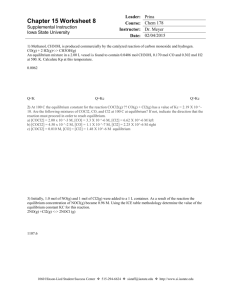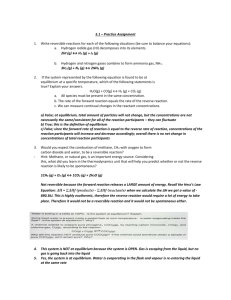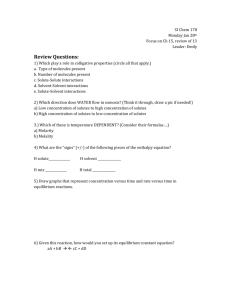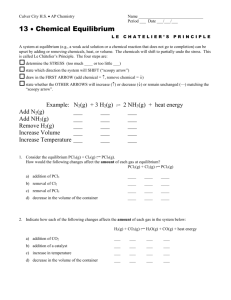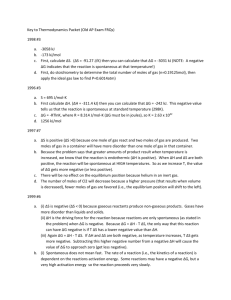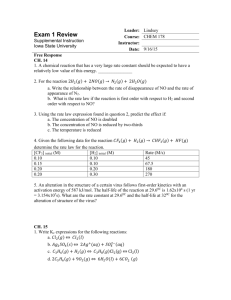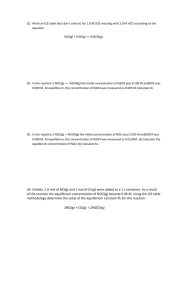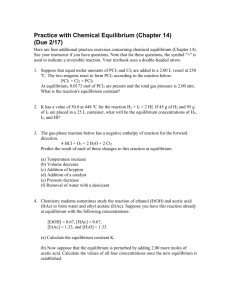Equilibrium: Concept Tests
advertisement
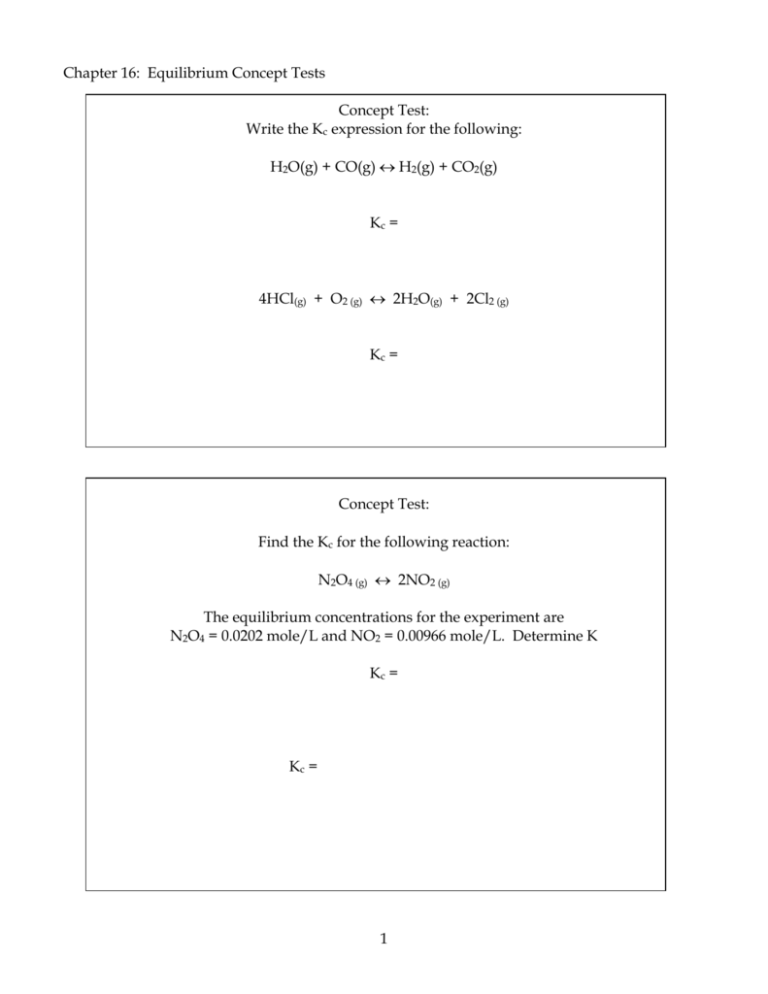
Chapter 16: Equilibrium Concept Tests Concept Test: Write the Kc expression for the following: H2O(g) + CO(g) H2(g) + CO2(g) Kc = 4HCl(g) + O2 (g) 2H2O(g) + 2Cl2 (g) Kc = Concept Test: Find the Kc for the following reaction: N2O4 (g) 2NO2 (g) The equilibrium concentrations for the experiment are N2O4 = 0.0202 mole/L and NO2 = 0.00966 mole/L. Determine K Kc = Kc = 1 2HI(g) Experiment Number 1 2 3 H2 (g) Initial Concentrations, M [HI] = 1.000 [H2] = 0.000 [I2] = 0.000 [HI] = 0.000 [H2] = 1.000 [I2] = 1.000 [HI] = 1.000 [H2] = 1.000 [I2] = 1.000 + I2 (g) at 698 K Equilibrium Concentrations, M [HI] = 0.786 [H2] = 0.107 [I2] = 0.107 [HI] = 1.573 [H2] = 0.213 [I2] = 0.213 [HI] = 2.360 [H2] = 0.320 [I2] = 0.320 Concept Test: Consider the case in which the decomposition of HI(g) produces equilibrium concentrations of H2 and I2 of 0.0250 M. Find the equilibrium concentration of HI Kc = Solve for HI HI = Write the equilibrium expression for the following reaction: 2NO(g) + O2 (g) 2NO2 (g) Kc = [NO2]2 = 4.67 x 1013 [NO]2[O2] Concept Test: Calculate the numerical value for the equation written in reverse = 2 [H2][I2] [HI]2 0.0185 0.0183 0.0184 What if we write the reaction in terms of the formation of 1 mole of NO2? NO(g) + ½ O2 (g) NO2 (g) What is the K of this reaction? Kc = [NO2] [NO][O2}1/2 How is THIS expression related to the original equation?? ORIGINAL EQUATION: Kc = [NO2]2 [NO]2[O2] What is the Kc for the formation of 1 mole of NO2? Kc 1 mole NO2 = Concept Test: Calculate the Kc expression for the following chemical reaction: NO2 (g) NO(g) + ½ O2 (g) Kc = 3 Concept Test: The reaction of steam and solid carbon produces a mixture of carbon monoxide and hydrogen. Write the equilibrium constant expression Kc for this reaction: C(s) + H2O (g) CO(g) + H2 (g) Kc = Concept Test: Write the Kp expression for the following reaction: N2 (g) + 3H2 (g) 2NH3 (g) Kp = From the above equation PNH3 = [NH3]RT and PN2 = [N2]RT and PH2 = [H2]RT Concept Test: Substitute the above relationships into the Kp expression: Kp = 4 Concept Test: Given the following equation, determine Kc H2 (g) + I2 (g) 2HI(g) Given 1.20 M of H2 and I2 and 0.347 M HI, calculate Kc Kc = Kc = Concept Test: If the Kc value for the above reaction = 8.36 x 10-2 and the concentrations For H2 and I2 = 0.133 M, what is the concentration of HI? Kc = [HI] = 5 Concept Test: When phosgene (COCl2) , a poisonous gas that has been used as a chemical warfare agent, is heated, it decomposes into carbon monoxide and chlorine gas Write and balance the chemical equation! When 2.00 moles of phosgene are put into a 1.00 L empty flask at 395oC and allowed to come to equilibrium, the final mixture contains 0.0398 moles of chlorine. Find Kc Remember - we need concentrations! We know the # moles and we know the volume – calculate M moles/ moles/ L= M phosgene L= M Cl2 Make your ICE table: fill in what you KNOW COCl2 (g) CO(g) I C E I = initial C = change E = equilibrium Kc = 6 + Cl2 (g) Concept Test: You are given 0.400 moles of HI gas is placed in a 1.00 L container and allowed to dissociate until it reaches equilibrium. At equilibrium, its concentration is 0.0156 M Calculate Kc Step 1: write balanced equation Step 2: create ICE table Step 3: fill in values Step 4: calculate Kc ↔ + I C E [Initial] – [Change] = [Equilibrium] 0.400 M = M 0.400 – = ↔ + I C E Kc = Kc = 7 Concept Test: When methane gas is mixed with water vapor in a 0.32 L flask, carbon monoxide and hydrogen gas are formed at 1200 K. At equilibrium, the flask contains 0.33 moles of CO, 0.088 moles of H2 and 0.025 moles of CH4. What is the [H2O] at equilibrium if the Kc = 0.33 Step 1: Write and balance the chemical reaction Step 2: Calculate equilibrium concentrations!! Step 3: Set-up equilibrium expression Step 4: solve for the missing value + ↔ + Kc = Kc = concentrations: moles CO/ moles H2/ L= moles CH4/ L= 0.33 = [H2O] = [H2O] = 8 L= M M M Concept Test: COCl2 (g) ↔ CO (g) + Cl2 (g) Kc = 8.3 x 10-4 at 360oC Calculate the equilibrium concentrations of each species at equilibrium in a 10.0 L flask if: a.) 5.00 moles of COCl2 decompose Step 1: Make sure equation is balanced Step 2: Make an ICE table Step 3: Calculate concentrations Step 4: Fill in the ICE table with values Step 5: Set-up equilibrium expression COCl2 (g) ↔ CO (g) + Cl2 (g) I C E Kc = Kc = 8.3 x 10-4 = let’s assume that x is small. Obviously, the creation of product in any amount is significant, but if x is small then we will not lose a lot of starting COCl2. Kc is on the smaller side, so we will make this assumption and see where it takes us. How accurate is our assumption: 5% rule Change in concentration x 100 < 5% then assumption is valid Initial concentration x 100 = % 0.500 Therefore, our assumption that x is small is valid [COCl2] = 0.500 – [CO] = [Cl2] = 9 Concept Test: COCl2 (g) ↔ CO (g) + Cl2 (g) Kc = 8.3 x 10-4 at 360oC Calculate the equilibrium concentrations of each species at equilibrium in a 10.0 L flask if: b.) 0.100 moles of COCl2 decompose Step 1: Make sure equation is balanced Step 2: Make an ICE table Step 3: Calculate concentrations Step 4: Fill in the ICE table with values Step 5: Set-up equilibrium expression COCl2 (g) ↔ CO (g) + Cl2 (g) I C E Kc = Kc = 8.3 x 10-4 = if we assume x is small then x = x 100 = % 0.0100 Therefore we cannot make this assumption x is significant: use quadratic formula! a quadratic expression: x= - b b 2 - 4ac 2a x= x= 10 x cannot be negative!! Remember x is the change – you cannot have a negative change! Product must be formed! Therefore, the only value for x that makes any sense is x= Therefore, the equilibrium concentrations are: [CO] = M [Cl2] = M [COCl2] = M Concept Test: PCl3 + Cl2 ↔ PCl5 Which way will the reaction shift if PCl5 is siphoned out of the reaction vessel? (PCl5 removed) Which way will the reaction shift if more PCl5 is added to the reaction vessel? Which way will the reaction shift if Cl2 is removed from the reaction vessel? If PCl3 is removed from the reaction vessel? Concept Test: Given 5.00 moles of gas, which is put in a 1.00 L container results in a concentration of 5.00 M if the same moles of gas is placed in a 2.00 L container, the concentration is? M if the same number of moles of gas is placed in a 0.500 L container the concentration is? M 11 Concept Test: Given the following reactions predict which direction they will shift if heat is ADDED to each of them: CaO(s) + H2O(l) Ca(OH)2 H = -82 kJ CaCO3 (s) CO2 (g) + CaO(s) H = 178 kJ 12
